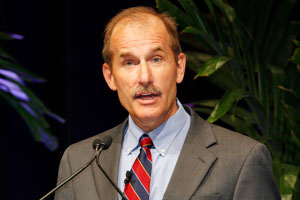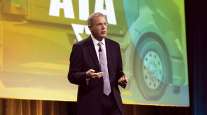'Miracle on the Hudson' Co-Pilot Says Lessons Learned Can Apply to Any Industry

 John Sommers II for Transport Topics
John Sommers II for Transport TopicsPHILADELPHIA — Call him the co-hero.
While Captain Chesley “Sully” Sullenberger has become famous for landing US Airways Flight 1549 in the Hudson River nearly seven years ago, co-pilot Jeff Skiles remained obscure until recently.
However, Skiles has begun sharing his tale of those incredible few minutes in the cockpit, and he did so on Oct. 20 at American Trucking Associations’ Management Conference & Exhibition here. Skiles said the “Miracle on the Hudson” was no miracle but was the result of a change in the airline’s culture that provided the training, preparation and procedures for the teamwork that proved critical to saving all 155 people onboard when the Airbus A320 landed in the frigid water on Jan. 15, 2009.
PANELISTS: Safety technology will help with driver recruitment
Skiles credited Sullenberger’s unparalleled leadership skill and calmness as well as the professionalism of the three flight attendants and the composure of the passengers, eight of whom incredibly chose to catch the next flight to Charlotte, for helping ensure that everyone survived.
However, Skiles said the “Miracle” also provided lessons that can be true of any industry, including trucking.
“We weren’t alone [in the plane] that day because of a revolution that has occurred in the aviation industry where we challenged everything we thought to be normal, and we changed how we operated,” Skiles said. “When I first began at US Air in 1986, safety efforts primarily focused on making the machine better. We developed sophisticated autopilots and GPS systems. Machines can take over the physical tasks of piloting an aircraft, but they’re less adept at strategic thought.”
Skiles said that back when he began flying for US Airways, pilots were assumed to be trained when they were hired. US Airways suffered five fatal crashes in five years in the early 1990s, but the major airlines haven’t had one in the United States in 14 years thanks to a newly developed focus on the crew, not the planes.
“There was no ongoing [safety] training,” he said. “We had a top-down management system dating from the early days of aviation where rank was everything. It took a number of years to change that culture. We developed procedures that required us to interact with each other. You reduce or eliminate so much human error by using two brains and two sets of eyes. Today, a pilot doesn’t fly an airliner. A crew flies an airliner. We learn from the collective experiences of the entire 5,000-pilot group. We boldly changed our industry.”
Sullenberger and Skiles hadn’t met until they began the trip four days earlier. And Skiles, who was in an Airbus cockpit for the first time that afternoon, although he had been with US Airways for more than two decades, was actually flying the plane until it hit a flock of birds that destroyed one engine and crippled the other, at which point the more senior pilot took command.
“Twenty years ago, Sully would’ve had to do everything, and I would’ve been waiting for orders,” Skiles said. “[But on Flight 1549], all I needed was to hear him say, ‘My aircraft’ and I knew my role changed to troubleshooter. There wasn’t much verbal communication between us. We never made eye contact, but … we knew what we could depend on each other to do. We accomplished our individual goals and thus worked together seamlessly. We had spent decades making the machines safer, but only when we chose to start focusing on the people and giving them the tools to be successful to work with this amazing technology, only then could we truly achieve real safety in the aviation industry.”



